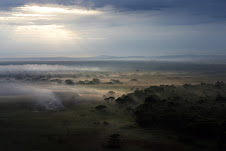Hieronder heb ik een artikel artikel gekopieerd om mijn stelling te onderstrepen; het is uit Travel Africa – Zambia’s 10 greatest safari experiences - Summer 2008. De foto’s zijn van Kieran Dodds.

BEHOLDING BATS
Kasanka National Park Zambia Picture 3500 tonnes of roosting bats, each with almost metre-wide wingspans, hanging from the trees above you…
Imagine over eight million mammals in just one hectare of forest – a staggering and exciting figure. Now picture that 3500 tonnes of biomass as roosting bats, each with an almost metre-wide wingspan, hanging from the trees above you… Is it now a frightening figure? It shouldn’t be.
Each year, beginning in late October, millions of straw-coloured fruit bats participate in one of Africa’s most spectacular, yet least-known migrations. Descending on the woodlands of Kasanka National Park, the bat colonies continue to converge on a small section of forest, swelling their numbers until they peak at a mind-blowing eight million by mid-November. This, the largest known aggregation of fruit bats in the world, is due to the small forest’s super-abundance of wild fruits, especially those growing on the water berry, wild loquat and red milkwood trees. The bats return the favour of the fabulous feed by spreading and depositing seeds (along with huge amounts of fertilizer), something that is crucial to the propagation and regeneration of wild fruit trees. After just two months of feasting in Kasanka, the bats have exhausted the fruit supply and head o
 ff in a northwesterly direction for their 2000km journey into the Democratic Republic of Congo.
ff in a northwesterly direction for their 2000km journey into the Democratic Republic of Congo. An ideal vantage point to witness this momentous migration is a spectacular tree-hide high in a red mahogany tree overlooking the Kapabi Swamp. Around 6pm the bats begin to take to the skies en masse, and for the next half hour the seemingly endless procession swarms overhead. Their sheer numbers and enormous wingspans darken the sky before disappearing into the twilight to feed. As dawn breaks advance squadrons reappear on the horizon, and within minutes the morning sky is obscured behind black clouds of bats.
Kasanka was the first privately managed national park in Zambia. The Kasanka Trust was established to protect the park’s wetlands and vitally important forest, and to secure the bats’ future. Visits are most rewarding during the last three months of the year when the bats are in residence. However, the massive ‘flying rodents’ are not the only creatures on call in Kasanka. Raptors, crocodiles, monitor lizards, snakes, civets and even the occasional leopard can be observed searching the forest floor for easy straw-coloured meals. Often, it’s the sheer
 weight of the colony that pulls branches off the trees, taking an unlucky few bats down to the hungry crowd below. Kasanka also boasts the greatest sitatunga viewing opportunities in Africa.
weight of the colony that pulls branches off the trees, taking an unlucky few bats down to the hungry crowd below. Kasanka also boasts the greatest sitatunga viewing opportunities in Africa.Regardless of what other species you might be fortunate enough to see, the sight of a bat blizzard filling the twilight sky is something everyone should experience – it is one of Africa’s most magnificent wildlife spectacles.


.jpg)



Geen opmerkingen:
Een reactie posten